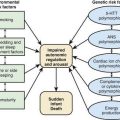Chapter 250 Influenza Viruses
Pathogenesis
Influenza virus causes a lytic infection of the respiratory epithelium with loss of ciliary function, decreased mucus production, and desquamation of the epithelial layer. These changes permit secondary bacterial invasion, either directly through the epithelium or, in the case of the middle ear space, through obstruction of the normal drainage through the eustachian tube. Influenza types A and B have been reported to cause myocarditis, and influenza type B can cause myositis. Reye syndrome can result with the use of salicylates during influenza type B infection (Chapter 353).
Clinical Manifestations
Influenza types A and B cause predominantly respiratory illness. The onset of illness is abrupt and is dominated by fever, myalgias, chills, headache, malaise, and anorexia; coryza, pharyngitis, and dry cough are associated features overshadowed by the other systemic signs (Table 250-1). The predominant symptoms may localize anywhere in the respiratory tract, producing an isolated upper respiratory tract illness, croup, bronchiolitis, or pneumonia. More than any other respiratory virus, influenza virus causes systemic signs such as high temperature, myalgia, malaise, and headache. Many of these signs and symptoms may be mediated through cytokine production by the respiratory tract epithelium, because there is no systemic spread of the virus. The typical duration of the febrile illness is 2-4 days. Cough may persist for longer periods, and evidence of small airway dysfunction is often found weeks later.
Table 250-1 RELATIVE FREQUENCY OF SYMPTOMS AND SIGNS DURING CLASSIC INFLUENZA IN OLDER CHILDREN AND ADOLESCENTS
| VARIABLE | OCCURRENCE |
|---|---|
| SYMPTOMS | |
| Chilly sensation | ++++ |
| Cough | +++ |
| Headache | +++ |
| Sore throat | +++ |
| Prostration | ++ |
| Nasal stuffiness | ++ |
| Diarrhea | ++ |
| Dizziness | + |
| Eye irritation or pain | + |
| Vomiting | + |
| Myalgia | + |
| SIGNS | |
| Fever | ++++ |
| Pharyngitis | +++ |
| Conjunctivitis (mild) | ++ |
| Rhinitis | ++ |
| Cervical lymphadenopathy | + |
| Pulmonary rales, wheezes, or rhonchi | + |
++++, 76-100%; +++, 51-75%; ++, 26-50%; +, 1-25%.
Diagnosis and Differential Diagnosis
Treatment
Two classes of antiviral drugs may be effective in the treatment of influenza. Guidelines for the use of the neuraminidase inhibitors zanamivir and oseltamivir against the novel H1N1 virus include use for children from the ages of 7 yr and 1 yr, respectively (Table 250-2). These drugs are given either as an inhalation (zanamivir) or orally (oseltamivir). Their effectiveness can be strain specific, as exemplified by the current seasonal H1N1 virus, which is resistant to oseltamivir but sensitive to zanamivir. Oseltamivir is not approved for use in children younger than 1 yr. Limited safety data on oseltamivir treatment of seasonal influenza in children younger than 1 yr suggest that severe adverse events are rare. Oseltamivir is authorized for emergency use in children younger than 1 yr by the U.S. Food and Drug Administration (Table 250-3).
Table 250-2 ANTIVIRAL MEDICATION DOSING RECOMMENDATIONS FOR TREATMENT OR CHEMOPROPHYLAXIS OF 2009 H1N1 INFECTION*
| MEDICATION | TREATMENT (5 DAYS) | CHEMOPROPHYLAXIS (10 DAYS) |
|---|---|---|
| OSELTAMIVIR | ||
| Adults | 75-mg capsule twice per day | 75-mg capsule once per day |
| Children ≥ 12 months: | ||
| ≤15 kg (≤33 lbs) | 30 mg twice daily | 30 mg once per day |
| >15-23 kg (>33-51 lbs) | 45 mg twice daily | 45 mg once per day |
| >23-40 kg (>51-88 lbs) | 60 mg twice daily | 60 mg once per day |
| >40 kg (>88 lbs) | 75 mg twice daily | 75 mg once per day |
| ZANAMIVIR | ||
| Adults | 10 mg (two 5-mg inhalations) twice daily | 10 mg (two 5-mg inhalations) once daily |
| Children (≥7 yr or older for treatment, ≥5 yr for chemoprophylaxis) | 10 mg (two 5-mg inhalations) twice daily | 10 mg (two 5-mg inhalations) once daily |
* Published as Updated interim recommendations for the use of antiviral medications in the treatment and prevention of influenza for the 2009-2010 season October 16, 2009; available at www.cdc.gov/h1n1flu/recommendations.htm. For current details, consult annually updated recommendations from the Advisory Committee on Immunization Practices of the Centers for Disease Control and Prevention, at www.cdc.gov/flu/.
Table 250-3 OSELTAMIVIR DOSING RECOMMENDATIONS FOR ANTIVIRAL TREATMENT OR CHEMOPROPHYLAXIS IN CHILDREN <1 YR*
| AGE | RECOMMENDED TREATMENT DOSE FOR 5 DAYS | RECOMMENDED PROPHYLAXIS DOSE FOR 10 DAYS |
|---|---|---|
| <3 mo | 12 mg twice daily | Not recommended unless situation judged critical, because of limited data on use in this age group |
| 3-5 mo | 20 mg twice daily | 20 mg once daily |
| 6-11 mo | 25 mg twice daily | 25 mg once daily |
* Published as Updated interim recommendations for the use of antiviral medications in the treatment and prevention of influenza for the 2009-2010 season October 16, 2009; available at www.cdc.gov/h1n1flu/recommendations.htm. For current details, consult annually updated recommendations from the Advisory Committee on Immunization Practices of the Centers for Disease Control and Prevention, at www.cdc.gov/flu/.
Supportive Care
Adequate fluid intake and rest are important components in the management of influenza. Acetaminophen or ibuprofen (but not salicylates because of the risk for Reye syndrome; Chapter 353) should be used as antipyretics to control fever. The most difficult question for parents is the appropriate timing of consultation with a health care provider. Bacterial superinfections are relatively common, and when they occur, antibiotic therapy should be administered. Bacterial superinfections should be suspected with recrudescence of fever, prolonged fever, or deterioration in clinical status. With uncomplicated influenza, children should feel better after the 1st 48-72 hr of symptoms.
Prevention
Vaccines
Inactivated and live-attenuated seasonal influenza vaccines with H3, H1, and B strains become available each summer, their formulations having incorporated changes to reflect the strains anticipated to circulate in the coming winter. The Advisory Committee on Immunization Practices publishes guidelines for their use each year when the vaccines are formulated and released. These guidelines are widely publicized but appear initially in the Morbidity and Mortality Weekly Report published by the CDC. Anyone who wants to reduce his or her chances of acquiring influenza can be vaccinated. It is recommended that all children are at special risk of influenza receive vaccination (Table 250-4). Nevertheless, certain high-risk groups should be prioritized, particularly when vaccine is in short supply or is made late in the year in response to an emerging epidemic. Guidelines are sufficiently complicated and differ enough from year to year that only the following broad recommendations can be given:
Table 250-4 SUMMARY OF SEASONAL INFLUENZA VACCINATION RECOMMENDATIONS, 2009: CHILDREN AND ADOLESCENTS AGED 6 MO-18 YR*
All children aged 6 mo-18 yr should be vaccinated annually.
Children and adolescents at higher risk for influenza complications should continue to be a focus of vaccination efforts as providers and programs transition to routinely vaccinating all children and adolescents, including those who:
* Children aged <6 mo cannot receive influenza vaccination. Household and other close contacts (e.g., daycare providers) of children aged <6 mo, including older children and adolescents, should be vaccinated.
Chemoprophylaxis
Amantadine, oseltamivir, and zanamivir are licensed for prophylaxis of influenza A infections (see Table 250-2). These agents are recommended as a 10-day course for prophylaxis for vaccinated and unvaccinated high-risk patients and their unvaccinated health care providers during influenza A outbreaks in closed settings, for unvaccinated persons and health care providers during community influenza A outbreaks, and for immunodeficient persons and those for whom the influenza vaccine is contraindicated during the period of peak influenza A activity.
Ampofo K, Herbener A, Blaschke AJ, et al. Association of 2009 pandemic influenza A (H1N1) infection and increased hospitalization with parapneumonic empyema in children in Utah. Pediatr Infect Dis J. 2010;29(10):905-909.
Baden LR, Drazen JM, Kritek PA. H1N1 Influenza A disease—information for health professionals. N Engl J Med. 2009;360:2666-2667.
Beigel JH, Farrar J, Han AM, et al. Avian influenza A (H5N1) infection in humans. N Eng J Med. 2005;353:1374-1385. (erratum in N Engl J Med 354:884, 2006)
Belshe RB, Edwards KM, Vesikari T, et al. Live attenuated versus inactivated influenza vaccine in infants and young children. N Engl J Med. 2007;356:685-696.
Bhat N, Wright JG, Broder KR, et al. Influenza-associated deaths among children in the United States, 2003–2004. N Engl J Med. 2005;353:2559-2567.
Bratincsak A. Fulminant myocarditis associated with pandemic H1N1 influenza A virus in children. J Am Coll Cardiol. 2010;55(9):928-929.
Centers for Disease Control and Prevention. Prevention and control of seasonal influenza with vaccines recommendations of the Advisory Committee on Immunization Practices (ACIP). MMWR Recomm Rep. 2009;58(RR08):1-52.
Centers for Disease Control and Prevention. Oseltamivir-resistant novel influenza A (H1N1) virus infection in two immunosuppressed patients—Seattle, Washington, 2009. MMWR Morb Mortal Wkly Rep. 2010;58:893-896.
Centers for Disease Control and Prevention. Deaths related to 2009 pandemic influenza A (H1N1) among American Indian/Alaska natives—12 states, 2009. MMWR Morb Mortal Wkly Rep. 2009;58:1341-1344.
Harper SA, Bradley JS, Englund JA, et al. Seasonal influenza in adults and children—diagnosis, treatment, chemoprophylaxis, and institutional outbreak management: clinical practice guidelines of the Infectious Diseases Society of America. Clin Infect Dis. 2009;48:1003-1032.
Lee VJ, Yap J, Cook AR, et al. Oseltamivir ring prophylaxis for containment of 2009 H1N1 influenza outbreaks. N Engl J Med. 2010;362:2166-2174.
Mangtani P, Mak TK, Pfeifer D. Pandemic H1N1 infection in pregnant women in the USA. Lancet. 2009;374:429-430.
Monsalvo AC, Batalle JP, Lopez MF, et al. Severe pandemic 2009 H1N1 influenza disease due to pathogenic immune complexes. Nat Med. 2011;17(2):195-199.
Morens DM, Taubenberger JK, Fauci AS. The persistent legacy of the 1918 influenza virus. N Engl J Med. 2009;361:225-229.
Moscona A. Neuraminidase inhibitors for influenza. N Engl J Med. 2005;353:1363-1373.
Neuzil KM, Mellen BG, Wright PF, et al. The effect of influenza on hospitalizations, outpatient visits, and courses of antibiotics in children. N Engl J Med. 2001;343:225-231.
Newland JG, Laurich M, Rosenquist AW, et al. Neurologic complications in children hospitalized with influenza: characteristics, Incidence, and risk factors. J Pediatr. 2007;150:306-310.
Ng S, Cowling BJ, Fang VJ, et al. Effects of oseltamivir treatment on duration of clinical illness and viral shedding and household transmission of influenza virus. Clin Infect Dis. 2010;50:707-714.
Novel Swine-Origin Influenza A (H1N1) Virus Investigation TeamDawood FS, Jain S, Finelli L, et al. Emergence of a novel swine-origin influenza (H1N1) virus in humans. N Engl J Med. 2009;360:2605-2614.
Ohmit SE, Monto AS. Symptomatic predictors of influenza virus positivity in children during the influenza season. Clin Infect Dis. 2006;43:564-568.
Shinde V, Bridges CB, Uyeki TM, et al. Triple-reassortment swine influenza A (H1) in humans in the United States, 2005–2008. N Engl J Med. 2009;360:2616-2624.
2009 Swine influenza: how much of a global threat? Lancet. 2009;373:1495.







